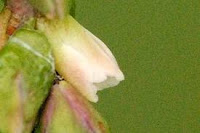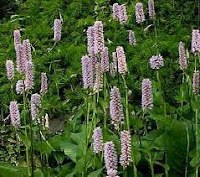Sugar beets were known for their sweetness and were developed form the white beet in the 18th century. Previously the white beet was Beta vulgaris maritima, so writing in the 17th century the English herbalist Nicholas Culpeper had this to say of the original white beet:-
“The common white beet hath many great leaves next the ground, somewhat large, and of a whitish green colour; the stalk is great, strong, and ribbed, bearing great store of leaves almost to the very top of it: the flowers grow in very long tufts, small at the ends, and turning down their heads, which are small, pale greenish-yellow, burs, giving corned prickly seed. The root is great, long, and hard, and when it hath given seed, is of no use at all….
Government and Virtues. The government of these two sorts of beet are far different, the red beet being under Saturn, and the white under Jupiter; therefore take the virtues of them apart, each by itself. The white beet doth much loosen the belly, and is of a cleansing digesting quality, and provoketh urine: the juce of it openeth obstructions, both of the liver and spleen, and is good for the head-ach and swimmings therein, and turnings of the brain; and is effectual also against all venomous creatures; and applied to the temples, stayeth inflammations in the eyes; it helpeth burnings, being used without oil, and with a little alum put to it, is good for St. Anthony's fire. Beet is hot and dry, and loosens the belly by reason of its nitrosity. It is an errhine, especially the root; for the juice of it received into the nostrils occasions sneeesing; the young plants, with their roots, gently boiled and eaten with vinegar, procure an appetite, extinguish thirst, and suppress choler in the stomach. Beet among the ancients was much noticed for its insipid taste, MARTIAL reproaches it in the following distich.
Ut sapiant fatuœ faborum prandia betœ.
O quam sœpe petet vina piperque coquus?
Insipid beet may bid a tradesman dine;
But ask of thee abundant spice and wine.
O quam sœpe petet vina piperque coquus?
Insipid beet may bid a tradesman dine;
But ask of thee abundant spice and wine.
The juice of this herb drawn up into the nostrils powerfully evacuates phlegmatic humours from the brain, and cures inveterate head-achs. This is counted a great secret by some. It is also good for all wheals, pushes, blisters, and blains, in the skin: the herb boiled, and laid upon chilblains, or kibes, helpeth them: the decoction thereof in water and some vinegar, healeth the itch, if bathed therewith, and cleanseth the head of dandruff, scurf and dry scabs, and doth much good for fretting and running sores, ulcers, and cankers, in the head, legs, or other parts, and is much commended against baldness and sheding of hair.”
Now the sugar beet is grown in the Northern hemisphere while sugar cane is grown in the Southern. Molasses for human consumption are from the latter, as is brown sugar, while white beets produce molasses as a by-product in the processing of sugar and these are used in the manufacture of citric acid, vinegar yeast and antibiotics. The tops and residue of the sugar beet pulp are used for cattle feed and dog food. The tops and the residue left over from processing sugar beet have potential for biomass and biofuel. Molasses from sugar beet production are used in the manufacture of citric acid, vinegar yeast and antibiotics.
Sugar beets have recently been under investigation as some of the substances, possibly betanin and choline, have been found to have the ability to kill human cancer tumour cells in vitro.
The mature sugar beet can be up to a foot long and weigh between three and five pounds; from one of this size, 5 ounces of white sugar can be produced. The sugar is sucrose.
The tubers used to be used to treat tumours in the intestines, and a decoction of the seeds was used as a remedy for tumours of the genitals. The juice has been applied externally to ulcers and used for skin problems too.
The sugar beet is a member of the Chenopodiaceous family or goosefoot family of plants, making it a relative of quinoa, stinking goosefoot, good King Henry, Fat Hen, and Marsh Samphire, to name but a few of its relatives.
The leaves may be used as a substitute for spinach and may be cooked or raw, although the raw leaves leave a disagreeable after-taste in the mouth. When the root is boiled some stringy fibres remain but it is edible. It can be grated finely and added to salads too, if you like the taste. However I think it is best left to make sugar with and of course there are its medical properties which are not new, but now there is some (but not overwhelming yet) scientific evidence to support its traditional use to kill cancerous tumours.



































